Hutton’s Unconformity – Siccar Point

A Scottish Site of Special Scientific Interest of global significance in the history of geology has received a boost from UK oil and gas company Siccar Point Energy. Named after Siccar Point in the Scottish Borders, the oil and gas operator has formed a partnership with Edinburgh Geological Society to back its efforts to improve the visitor experience around the remote site.
Siccar Point is famous as the site where, in 1788, Edinburgh based natural scientist James Hutton found the decisive evidence he sought for his Theory of the Earth – the never-ending cycles of creation and destruction that shape our landscape today. This theory overturned the last vestiges of the Biblical account of a world shaped by the receding waters of a universal flood. Controversial in its day, Hutton’s work is now a foundation stone in the science of geology.
As John Playfair later recorded of their visit “The mind seemed to grow giddy by looking so far into the abyss of time”. A concept of ‘deep time’ emerged with the recognition that the geological processes occurring around us today have operated over a long period and will continue to do so into the future.
You can visit Siccar Point today, and see the spectacular junction between two distinctive types of rock, just as Hutton himself found it.
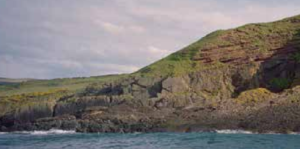
Hutton’s Unconformity- A Sea view of the angular discordance between strata
Copyright Edinburgh Geological Society
The two sets of rocks at Siccar Point are dark grey steeply tilted rocks formed in an ancient ocean, and the much younger, almost horizontal red rocks formed on land. The deposition of the two different types of rock was not continuous, but separated by a gap of 65 million years during which time the older rocks were changed and eroded.
Walk in James Hutton’s footsteps and explore the story of this remarkable man and our modern understanding of his geology, representing millions of years of erosion, deposition, folding, faulting and uplift.
BELOW THE UNCONFORMITY
Silurian greywacke sandstone and mudstone
These rocks formed as flat-lying layers in deep water during the Silurian period, about 435 million years ago. Greywacke is a type of hard sandstone containing a mixture of rock fragments in a fine matrix of clay. Thin layers of mudstone separate the greywacke layers, and together the rocks tell an interesting story of the conditions on the ocean floor. Most of the time, gentle ocean currents brought fine-grained mud into the deep sea, allowing the slow build up of layers that would eventually form mudstone. But every so often, dramatic, fast-moving torrents of sediment would be swept down the continental slope, forming layers of unsorted sandstone – the greywacke. These turbidity currents have been observed in modern oceans, and the greywacke layers at Siccar Point demonstrate that the same process happened here.
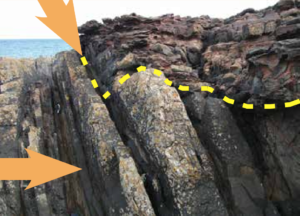
Hutton’s Unconformity – Silurian greywacke sandstone and mudstone overlain by the Upper Devonian basal conglomerate Copyright Edinburgh Geological Society
The Silurian strata at Siccar Point formed in the Iapetus Ocean, a long-lost ocean that separated two continents. As the Iapetus Ocean closed, the sea floor was subducted beneath the northern continent and some of the sea floor sedimentary rocks were buckled and compressed. The layers you can see at Siccar Point are now nearly vertical because of this tectonic movement.
After the ocean had closed, the ocean-floor rocks spent 65 million years at the surface, gradually being eroded. The softer mudstone layers wore away more easily, leaving the edges of the greywacke layers
ABOVE THE UNCONFORMITY
Upper Devonian red sandstones
These rocks occur widely across Scotland. They formed on land in a low-lying area experiencing a tropical climate with wet and dry seasons. Rivers deposited sand and silt as the wet season declined. In the dry season this material was blown about by the wind, sometimes into dunes. Soils were poorly developed and vegetation sparse, consequently the erosive power of the rivers was even greater than it is today. The red colour of the rocks results from the presence of iron oxide. The sands and silts were deeply buried and gradually converted into rocks.
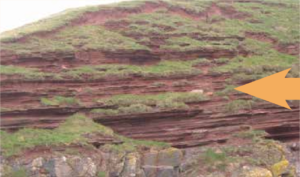
Hutton’s Unconformity – Upper Devonian red sandstones Copyright Edinburgh Geological Society
Upper Devonian basal conglomerate
Angular slab-like fragments of the underlying greywacke sandstone are common in the lowest layers of the red sandstones. These fragments were created from erosion of the older rocks, dumped on the land surface as talus (scree) and moved on by highly energetic, seasonal rivers flowing in desert wadis (valleys). The alignment of these fragments shows that the current flow in the wadis was from the northeast.
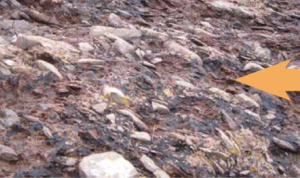
Hutton’s Unconformity – Upper Devonian basal conglomerate – Copyright Edinburgh Geological Society
What was Hutton looking for?
Hutton and his companions were well aware of the surrounding geology, and the landscape contrast between the older grey rocks – forming the hills of the Southern Uplands – and the younger rocks to the north and west that underlie more fertile farming areas. In making their boat journey along the coast, they were hoping to find a clear example of the unconformity exposed in a sea cliff.
The cliff on the south side of Siccar Point does show the unconformity very well, but Hutton was delighted to find that at the Point itself he could actually walk on the unconformity, “a beautiful picture of this junction washed bare by the sea” (Playfair).
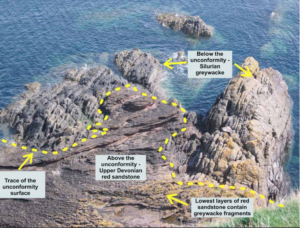
Hutton’s Unconformity – the view from above – Copyright Edinburgh Geological Society
The Edinburgh Geological Society actively promotes the Interpretation of field outcrop exposures in Scotland. This work is actively engaged with and promoted by Angus Miller and Neil Mackenzie (EGS).
Siccar Point Energy has provided funding to replace two interpretation boards and print 20,000 leaflets about Siccar Point and James Hutton.
The Siccar Point Hutton’s Unconformity leaflet can be downloaded:
https://edinburghgeolsoc.org/downloads/Siccar-Point-LBGC-leaflet.pdf
Siccar Point Energy is a Sustaining Sponsor of the PESGB’s objective of education into the scientific and technical aspects of petroleum exploration and encouraging the advancement of petroleum exploration in Great Britain
Acknowledgements
Text: Based on an original project by Alex Crabtree; taken forward by Angus Miller and other members of the Lothian and Borders GeoConservation Group.
Images: Edinburgh Geological Society and Andrew McMillan, Angus Miller, Mike Browne
John Wood, PESGB, 17-10-2018

